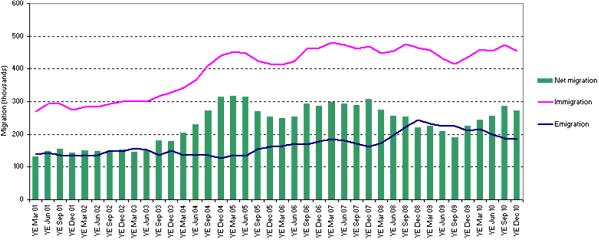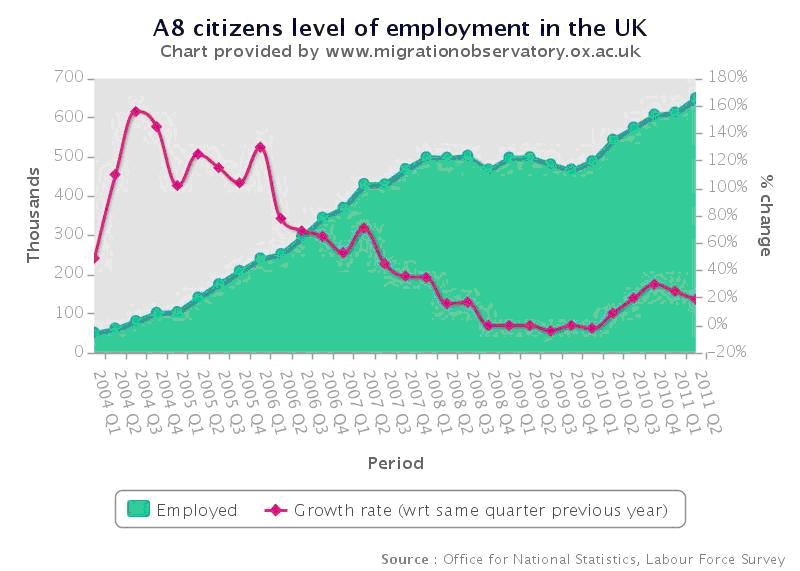by Matt Cavanagh
Yesterday’s ONS figures are a reminder of the risks of politicians promising what they can’t deliver, particularly on an issue as emotive as immigration.
Before the election, Conservatives and Liberal Democrats said immigration was out of control; afterwards, they said they would cut it dramatically. Neither was true.
The figures reinforce how stable immigration has been in recent years: non-British immigration is estimated at 455,000 in 2010, compared to 437,000 in 2009 – and broadly stable since 2006:
Long term immigration, emigration, and net migration of non-British nationals
The Government’s chosen target is not non-British immigration, but ‘net inward migration’: total (British and non-British) immigration, less total (British and non-British) emigration. As the above graph shows, non-British emigration is falling, and while British emigration has risen slightly over the last year, overall emigration remains down – with the result that the Government’s target of reducing net migration below 100,000 has moved further from their grasp since the election:
Long term immigration, emigration, and net migration of all nationals
Yesterday’s figures suggest the interim immigration ‘cap’ on working migrants from outside the EU had negligible effect in 2010. The Government has made further changes since relating to non-EU migrants, including closing Tier 1 (highly skilled) to all but the wealthiest migrants in December 2010; a number of changes to Tier 4 (students) in March 2011; and a permanent ‘cap’ on ‘Tier 2’ (skilled) workers in April.
The latest quarterly figures to June 2011, published by the Home Office yesterday, should show these changes starting to have an effect, and indeed there is a slight fall in people coming from outside the EU for work (down 2.7% compared to the year ending April 2011), almost all in Tier 1 rather than Tier 2. This fall is offset, however, by a rise in those coming from outside the EU to study (up 3.5% compared to year ending April 2011).
More significantly, any reduction in numbers coming from outside the EU is likely to be offset by the continuing rise in those coming from inside the EU, particularly from Eastern Europe – a category of immigration which the Government cannot control.
Yesterday’s figures show that immigration from Eastern Europe rose from 52,000 to 71,000 in 2010 – and emigration back to Eastern Europe fell from 47,000 to 31,000, adding further to overall net migration.
In terms of the number of Eastern Europeans in work – as opposed to new arrivals – recent Labour Force Survey figures confirm that, after being stable between 2008 and the first quarter of 2010, numbers have been rising steadily since the election:
The changes the Government has made to immigration from outside the EU may well have more effect in the year to come – particularly on students and highly-skilled migrants.
But the rising trend in immigration from the EU looks set to continue. More recent figures from the Department of Work and Pensions, included in yesterday’s ONS report, show that for the year to March 2011, over 187,000 National Insurance numbers were allocated to Eastern European nationals, an increase of 24% on the previous 12 months.
In terms of employers’ future plans, a survey this week from the Chartered Institute for Personnel Development suggests that the number of private sector employers intending to hire migrant workers in the next quarter continues to rise. The CIPD survey also suggests that, if the ‘cap’ has any effect in future months, it is unlikely to deter employers from hiring migrant workers – it is more likely to make them switch to hiring migrants from inside the EU.
Ministers need to be more honest with the public about how far overall immigration numbers are really determined by government policy, rather than economic factors, and employer preferences. Ministers also need to avoid reacting to their difficulties with the net migration target by trying to clamp down further on those categories of migration which are the most economically valuable – and instead, start thinking about how to harness immigration to promote employment and growth. Conservative ministers in particular have consistently argued that welfare reform and immigration control are the answer to youth unemployment and worklessness. But with youth unemployment back over 20%, and NEETs at a record high, they need to look towards other policies if they are to prevent the creation of another ‘lost generation’.
Matt Cavanagh is Associate Director at the IPPR
Tags: employment, government, immigration, Matt Cavanagh, migration












So what’s your solution? Lots of winging and political point scoring (or not) doesn’t help NEETS or anyone else?
What did Labour do over 14 years?
From the minute I saw D.Cameron live on the TV debates 2010 general election, it came apparent that, I would never ever buy a second hand car from this man. He came across a very insincere & desperate!! will do & say any thing for power….
Amy Winehouse put it quite well ‘Back to Black’.
The fact is that black culture has pervaded our lives to the extent that we don’t even realise it from music to sport to art.
And with more mixed race/dual heritage kids than ever before, black culture will be an integral part of everyones lives, even David Starkey’s.